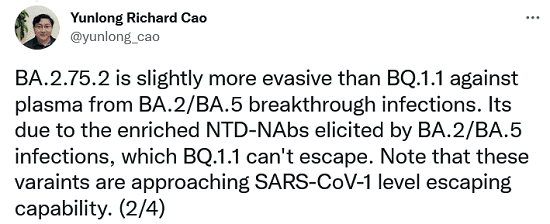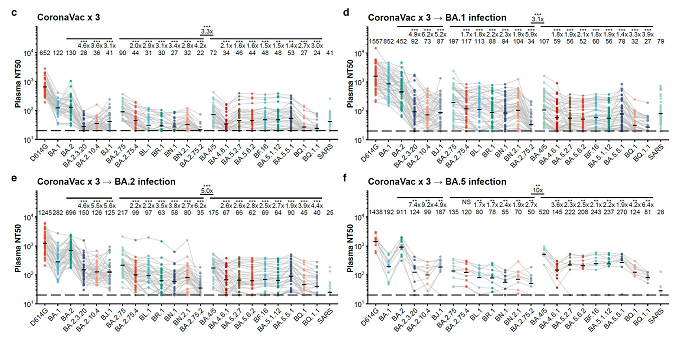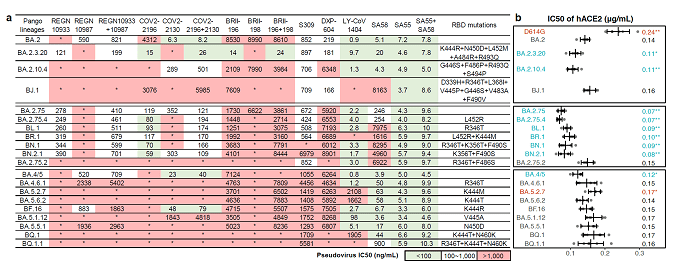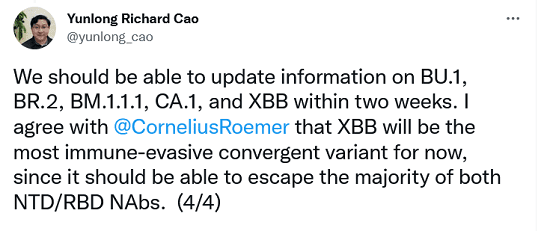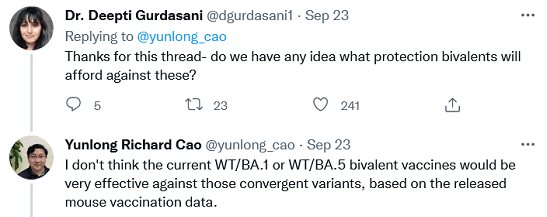
BA.2.75.2 and BQ.1.1 approaching SARS-1 levels of escape
A new Twitter thread out today from Yunlong Cao gives further details about the variants BA.2.75 and BQ.1.1.
“Updating information regarding convergent variants BA.2.3.20, BN.1, BA.2.10.4, BN.2.1, BA.4.6.1, BQ.1, BQ.1.1. In short, BA.2.75.2 and BQ.1.1 are the most antibody-evasive convergent variants tested, far exceeding BA.5 and approaching SARS-CoV-1 level. (1/4)”
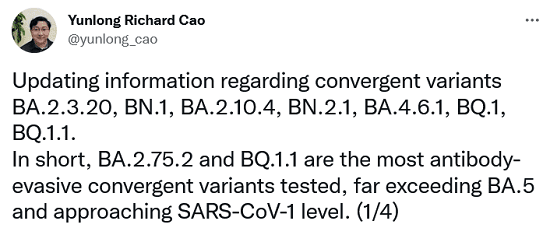
“BA.2.75.2 is slightly more evasive than BQ.1.1 against plasma from BA.2/BA.5 breakthrough infections. Its due to the enriched NTD-NAbs elicited by BA.2/BA.5 infections, which BQ.1.1 can’t escape. Note that these variants are approaching SARS-CoV-1 level escaping capability. (2/4)“
“As expected, BQ.1.1 escapes Evusheld and bebtelovimab, making all clinically available antibody drugs ineffective. BQ.1.1 and BA.2.75.2 both displayed sufficient hACE2 binding capability. (3/4)”
“We should be able to update information on BU.1, BR.2, BM.1.1.1, CA.1, and XBB within two weeks. I agree with @CorneliusRoemer that XBB will be the most immune-evasive convergent variant for now, since it should be able to escape the majority of both NTD/RBD NAbs. (4/4)”
Do we have any idea what protection bivalent [vaccines] will afford against these?
“I don’t think the current WT/BA.1 or WT/BA.5 bivalent vaccines would be very effective against those convergent variants, based on the released mouse vaccination data.”
Yunlong Cao has already featured in two other posts on Coronaheadsup.com about BA.2.75.2 and other variants of interest. You can find the posts here and here.
Cornelius Roemer: “BQ.1.1 is showing quite some growth, especially in England where the first sample was submitted 9 days ago and now there are already 28 sequences. I hope there is some sort of biased sampling going on. Otherwise this doesn’t look good.”
BQ.1.1 is showing quite some growth, especially in England where the first sample was submitted 9 days ago and now there are already 28 sequences.
I hope there is some sort of biased sampling going on. Otherwise this doesn't look good.@PeacockFlu @kallmemeg @theosanderson pic.twitter.com/cteUne84Cv— Cornelius Roemer (@CorneliusRoemer) September 21, 2022
Here's the latest variant picture for the recently-designated BQ.1.* lineage, including BQ.1.1 nickname "Asterius".
It has recently been rising sharply in the UK, over 4% of recent samples.
There are some signs of growth, mostly in other European countries.
🧵 pic.twitter.com/5k7J3VRA4e— Mike Honey (@Mike_Honey_) September 22, 2022
BA.2.75.2: The “most immune evasive strain we have tested so far”
Photo by Salih Enes Alkan on Unsplash
